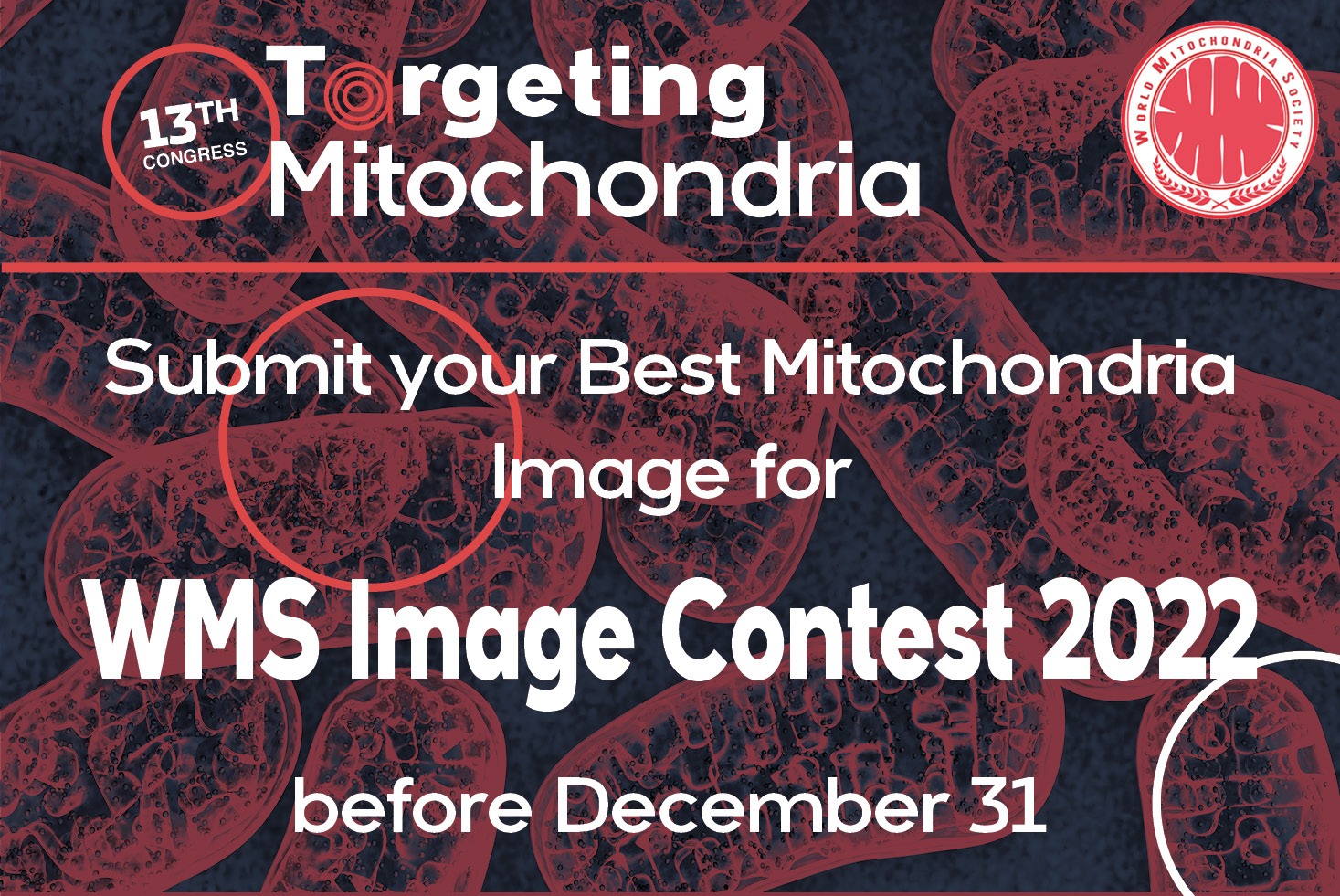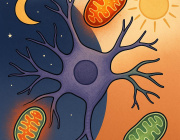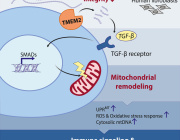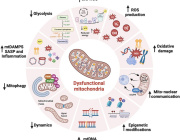Targeting Mitochondria 2022 Online Posters

Please find here all Online posters presented during the Targeting Mitochondria 2022 Congress. The abstract of each poster is included in Abstracts Book of congress.
Did you participate in Targeting Mitochondria 2022?
The all presented major & short oral communications will be available as recorded presentations shortly.
Did not attend but wish to access to the Replay :
To access to the Congress & Workshop recorded presentations and get the Abstracts Book of congress & workshop, please contact us.
Best Mitochondria Image Contest 2022

Submit a memorable Mitochondria Image you’ve taken this past year and get the chance to win a free registration for the next congress to be held in 2023! The scientific committee also accept artwork and drawings related to Mitochondria (life, death, energy, dynamics and philosophy...).
Entries must be original and contestants should be registered to the Targeting Mitochondria 2022 congress. Results will be announced at the begining of 2023.
Image Submission Guidelines
To enter the contest, please make sure to send us the following information on a Word Document:
1. Your name
2. Your complete affiliation
3. A picture of you (optional)
4. Your Mitochondria Image with:
- A title
- The description of the image
- The context of the study
and send it to: This email address is being protected from spambots. You need JavaScript enabled to view it.">This email address is being protected from spambots. You need JavaScript enabled to view it.
May the best image Win!
Prof. Wallace: Keynote Speaker at WMS 2022

IIt was a great pleasure to welcome Prof. Douglas C. Wallace, Children's Hospital of Philadelphia, USA, at Targeting Mitochondria 2022 congress. He introduced the meeting with a keynote speech on Mitochondrial Medicine : Present and Future.
Dr. Wallace is a geneticist and evolutionary biologist who founded the field of mitochondrial medicine 40 years ago. He investigates the role of mitochondria in human evolution, health, and disease.
Targeting Mitochondria 2022 Congress
October 26-28, 2022 - Berlin, Germany
Recent Advances in Mitochondrial Transplantation Therapy
 Dr. James D. McCully, from The Harvard Medical School Department of Cardiac Surgery Boston Children’s Hospital, USA, will join us this year to present his most recent findings on "Recent Advances in Mitochondrial Transplantation Therapy".
Dr. James D. McCully, from The Harvard Medical School Department of Cardiac Surgery Boston Children’s Hospital, USA, will join us this year to present his most recent findings on "Recent Advances in Mitochondrial Transplantation Therapy".
Join us in Targeting Mitochondria 2022 and benefit from the experience of professional researchers in this field. Book your spot.
Targeting Mitochondria 2022 Congress
October 26-28, 2022 - Berlin, Germany
wms-site.com
Regulation of Mitochondrial DNA Polymerase POLG1 Proteolysis and its Role in the Progeroid Disease Cockayne Syndrome and Physiological Ageing
 Dr. Miria Ricchetti, Institut Pasteur, France will join us this year to present her most recent findings on "Regulation of Mitochondrial DNA Polymerase POLG1 Proteolysis and its Role in the Progeroid Disease Cockayne Syndrome and Physiological Ageing".
Dr. Miria Ricchetti, Institut Pasteur, France will join us this year to present her most recent findings on "Regulation of Mitochondrial DNA Polymerase POLG1 Proteolysis and its Role in the Progeroid Disease Cockayne Syndrome and Physiological Ageing".
The mechanisms of proteolysis and proteostasis of several mitochondrial matrix proteins are known. This was not the case for the pivotal polymerase POLG1 that ensures the replication of the mitochondrial genome. Dr. Ricchetti and her team show here a mechanism that leads to POLG1 degradation and has implications in pathophysiological ageing.
Join us in Targeting Mitochondria 2022 and benefit from the experience of professional researchers like Dr. Ricchetti. Book your spot.
Targeting Mitochondria 2022 Congress
October 26-28, 2022 - Berlin, Germany
Targeting the Mitochondrial Unfolded Protein Response in Prostate Cancer
 Dr. Dhyan Chandra, Roswell Park Comprehensive Cancer Center, USA will join us this year to present his most recent findings on "Targeting the Mitochondrial Unfolded Protein Response in Prostate Cancer".
Dr. Dhyan Chandra, Roswell Park Comprehensive Cancer Center, USA will join us this year to present his most recent findings on "Targeting the Mitochondrial Unfolded Protein Response in Prostate Cancer".
Dr. Dhyan Chandra has identified the mitochondrial unfolded protein response (UPRmt) as a new target for prostate cancer treatment and management. His research team revealed that the two key components of the UPRmt, heat shock protein 60 (HSP60, a mitochondrial chaperonin) and caseinolytic protease (ClpP, a mitochondrial protease) work together and are required for the development of advanced prostate cancer. They observed that HSP60 acts as upstream regulator of ClpP expression and HSP60 interacts with ClpP to maintain mitochondrial function.
Dr. Chandra has also discovered a novel UPRmt (referred to as DCEM1) that inhibits HSP60 interactions with ClpP in prostate cancer cells and prostate tumors, leading to the blockade prostate cancer growth and progression in preclinical study. Since the current androgen deprivation and taxane-based therapy are not effective, these findings provide alternative treatment approaches for prostate cancer that do not rely on androgen receptor signaling axis.
Join us in Targeting Mitochondria 2022 and benefit from the experience of professional researchers like Dr. Chandra. Book your spot.
Targeting Mitochondria 2022 Congress
October 26-28, 2022 - Berlin, Germany
Mitochondrial DNA as Extracellular Vesicle Cargo in Aging and Age-related Conditions

Dr. Nicole Noren Hooten from the National Institute on Aging, National Institutes of Health, USA will join us this year to present her recent findings on “Mitochondrial DNA as Extracellular Vesicle Cargo in Aging and Age-related Conditions” in a session entitled “Extracellular Vesicles & Mitochondria: The Target”
Mitochondrial DNA (mtDNA) can be released into the extracellular space as circulating cell-free mitochondria DNA (ccf-mtDNA). Recent findings from our laboratory indicate that ccf-mtDNA in plasma can be encapsulated in extracellular vesicles (EVs). EVs are small nano-sized particles that are released by cells into the circulation and shuttle bioactive cargo as part of intercellular communication systems.
Dr. Noren Hooten's talk will discuss the role of mitochondrial DNA in extracellular vesicles in the context of aging and age-related conditions.
Join us in Targeting Mitochondria 2022 and benefit from the experience of professional researchers like Dr. Noren Hooten. Remember that you too can present your most recent findings related to this session by submitting your abstract.
Targeting Mitochondria 2022 Congress
October 26-28, 2022 - Berlin, Germany
wms-site.com
The Impact of Mesenchymal Stromal Cell Extracellular Vesicles on Mitochondrial Dysfunction in Acute Respiratory Distress Syndrome
 Dr. Anna Krasnodembskaya from Queen's University Belfast, The United Kingdom, will join us this year to present her most recent findings on "The Impact of Mesenchymal Stromal Cell Extracellular Vesicles on Mitochondrial Dysfunction in Acute Respiratory Distress Syndrome" in a session entitled "Extracellular Vesicles & Mitochondria: The Target".
Dr. Anna Krasnodembskaya from Queen's University Belfast, The United Kingdom, will join us this year to present her most recent findings on "The Impact of Mesenchymal Stromal Cell Extracellular Vesicles on Mitochondrial Dysfunction in Acute Respiratory Distress Syndrome" in a session entitled "Extracellular Vesicles & Mitochondria: The Target".
Join us in Targeting Mitochondria 2022 and benefit from the experience of professional researchers like Dr. Krasnodembskaya. Remember that you too can present your most recent findings related to this session by submitting your abstract.
Targeting Mitochondria 2022 Congress
October 26-28, 2022 - Berlin, Germany
wms-site.com
Autologous Mitochondrial Transplant for Cerebral Ischemia
 Dr. Melanie Walker from the University of Washington Medical School, USA, will join us this year to present her most recent findings on "Autologous Mitochondrial Transplant for Cerebral Ischemia".
Dr. Melanie Walker from the University of Washington Medical School, USA, will join us this year to present her most recent findings on "Autologous Mitochondrial Transplant for Cerebral Ischemia".
Stroke is one of the leading causes of morbidity and mortality worldwide. More than 80% of strokes are the result of ischemia caused by blockage of one or more cerebral arteries. Lack of blood supply starves brain cells of necessary glucose and oxygen, and disturbs cellular homeostasis, eventually resulting in neuronal death. Based on many preclinical studies in animals, damage caused by ischemia can be reversed after infusing healthy mitochondria into injured tissues. An ongoing clinical trial in human hearts at Boston Children's Hospital has also demonstrated that transplanting autologous mitochondria via infusion or direct injection is well-tolerated and safe.
Dr. Walker and her clinical research team are currently recruiting for a first-in-human-brain trial to assess the safety of mitochondrial transplantation for ischemic-reperfusion injury in the brain. She will discuss their preclinical studies and status of their clinical trial.
Join us in Targeting Mitochondria 2022 and benefit from the experience of professional researchers like Dr. Walker. Book your spot.
Targeting Mitochondria 2022 Congress
October 26-28, 2022 - Berlin, Germany
wms-site.com
Mitochondrial and Photo-Medicine - Recent Clinical Applications
 Dr. med. Michael Weber, President of European Laser Academy, Germany will join us this year to present his most recent findings on "Mitochondrial and Photo-Medicine - Recent Clinical Applications".
Dr. med. Michael Weber, President of European Laser Academy, Germany will join us this year to present his most recent findings on "Mitochondrial and Photo-Medicine - Recent Clinical Applications".
Join us in Targeting Mitochondria 2022 and benefit from the experience of professional researchers like Dr. Weber. Book your spot.
Targeting Mitochondria 2022 Congress
October 26-28, 2022 - Berlin, Germany
wms-site.com
Folic Acid Supplementation Improves Drosophila Parkin Loss-of-Function Phenotype and Decreases Mitochondrial Hydrogen Peroxide Levels in Vulnerable Dopaminergic Neurons
 Dr. Lori Buhlman, from Midwestern University Glendale, USA, will join us this year to present her most recent findings on "Folic Acid Supplementation Improves Drosophila Parkin Loss-of-Function Phenotype and Decreases Mitochondrial Hydrogen Peroxide Levels in Vulnerable Dopaminergic Neurons".
Dr. Lori Buhlman, from Midwestern University Glendale, USA, will join us this year to present her most recent findings on "Folic Acid Supplementation Improves Drosophila Parkin Loss-of-Function Phenotype and Decreases Mitochondrial Hydrogen Peroxide Levels in Vulnerable Dopaminergic Neurons".
A major hallmark of Parkinson’s disease (PD) is selective degeneration of dopaminergic neurons within the substantia nigra pars compacta. While the vast majority of PD cases are idiopathic, a small percent of patients inherits disease-causing mutations in the PRKN gene, which encodes the parkin protein.
Parkin loss-of-function Drosophila have motor deficits and selective neurodegeneration in the protocerebral posterior later region 1 (PPL1), which is functionally homologous to the human substantia nigra. Dr. Buhlman uses this model to search for unique features that make PPL1 neurons vulnerable.
Mitochondrial dysfunction and oxidative stress are heavily implicated in neurodegeneration; however, how loss of parkin leads to cell death is unclear. Using redox-sensitive cell-specific fluorescent reporters, Dr. Buhlam observed that elevated hydrogen peroxide levels are sustained as the parkin loss-of-function fly ages in PPL1 neurons but not in an unaffected cluster of dopaminergic neurons. Interestingly, demand for glutathione, an important mitochondrial antioxidant, is only elevated in PPL1.
She hypothesized that low levels of glutathione, combined with increases in mitochondrial hydrogen peroxide levels contribute to the dysfunction of mitochondria, oxidative stress and PPL1 neurodegeneration. To address this, she has repeated her study in flies raised on a folic acid-supplemented diet to increase cysteine amino acid synthesis, as cysteine is the rate-limiting component of glutathione synthesis. Dr. Buhlman has observed increased lifespan, improved motor behavior, and decreased hydrogen peroxide levels in treated flies.
Her results could provide new information regarding the role of parkin in mitochondrial function and disease and indicate candidate therapeutic targets.
Join us in Targeting Mitochondria 2022 and benefit from the experience of professional researchers like Dr. Buhlman. Book your spot.
Targeting Mitochondria 2022 Congress
October 26-28, 2022 - Berlin, Germany
wms-site.com
Noninvasive Treatment of Brain Ischemia-Reperfusion Injury With Near Infrared Light: Working Toward Clinical Implementation
 Dr. Maik Hüttemann, from Wayne State University, USA, will join us this year to present his most recent findings on "Noninvasive Treatment of Brain Ischemia-Reperfusion Injury With Near Infrared Light: Working Toward Clinical Implementation" within a session, chaired by him, entitled "Translational Therapies - Focus on Infrared Therapies".
Dr. Maik Hüttemann, from Wayne State University, USA, will join us this year to present his most recent findings on "Noninvasive Treatment of Brain Ischemia-Reperfusion Injury With Near Infrared Light: Working Toward Clinical Implementation" within a session, chaired by him, entitled "Translational Therapies - Focus on Infrared Therapies".
Dr. Hüttemann has discovered specific wavelengths of near infrared light (IRL) that target and partially inhibit the mitochondrial enzyme cytochrome c oxidase (COX). Modulation of COX activity via IRL allows him to control the electron transport chain (ETC) and would be therapeutically beneficial in conditions where mitochondria are hyperactive, such as during reperfusion following an ischemic event. ETC hyperactivity is detrimental to neurons because it causes hyperpolarization of the mitochondrial membrane potential during reperfusion, leading to the generation of excessive amounts of reactive oxygen species (ROS).
Dr. Hüttemann shows that noninvasive application of COX-inhibitory IRL in small and large animal models of brain ischemia/reperfusion injury limits ROS production and is highly neuroprotective. To translate these findings into the clinic, efficient and safe IRL delivery to the human head is essential, which is achieved through novel silicone based IRL delivery patches.
Join us in Targeting Mitochondria 2022 and benefit from the experience of professional researchers in this field. Book your spot.
Targeting Mitochondria 2022 Congress
October 26-28, 2022 - Berlin, Germany
wms-site.com
A Non-canonical Tricarboxylic Acid Cycle Underlies Cellular Identity
 Dr. Paige Arnold, from the Memorial Sloan Kettering Cancer Center, USA, will join us this year to present her most recent findings on Tricarboxylic acid cycle, through a presentation entitled "A Non-canonical Tricarboxylic Acid Cycle Underlies Cellular Identity".
Dr. Paige Arnold, from the Memorial Sloan Kettering Cancer Center, USA, will join us this year to present her most recent findings on Tricarboxylic acid cycle, through a presentation entitled "A Non-canonical Tricarboxylic Acid Cycle Underlies Cellular Identity".
Dr. Arnold states that the tricarboxylic acid (TCA) cycle is a core metabolic pathway that produces reducing equivalents for energy production and critical biosynthetic intermediates. Despite the ubiquitous importance of TCA cycle-derived products for cell viability and proliferation, mammalian cells display significant heterogeneity in TCA cycle activity. The existence of diverse TCA cycle wiring across different cell types led her and her team to hypothesize that TCA cycle enzymes might assemble into multiple pathway configurations. By combining genetic co-essentiality mapping with isotope tracing studies in cancer cells and stem cells, they describe a biochemical alternative to the traditional TCA cycle that is cell-state dependent and required for cell fate transitions.
Join us in Targeting Mitochondria 2022 and benefit from the experience of professional researchers in this field.Book your spot.
Targeting Mitochondria 2022 Congress
October 26-28, 2022 - Berlin, Germany
wms-site.com
Mitochondria Transplantation Between Living Cells
 Dr. Julia A. Vorholt, from ETH Zurich, Switzerland, will join us this year to present her most recent findings on "Mitochondrial Transplantation Between Living Cells" in a session entitled "Mitochondria Transplantation and Transfer"
Dr. Julia A. Vorholt, from ETH Zurich, Switzerland, will join us this year to present her most recent findings on "Mitochondrial Transplantation Between Living Cells" in a session entitled "Mitochondria Transplantation and Transfer"
Mitochondria and the complex endomembrane system are hallmarks of eukaryotic cells. To date, it has been difficult to manipulate organelle structures within single live cells.
Dr. Vorholt developed a FluidFM-based approach to extract, inject and transplant organelles directly from and into living cells with subcellular spatial resolution. The technology combines atomic force microscopy, optical microscopy and nanofluidics to achieve force and volume control with real-time inspection.
The approach enables the transfer of controlled quantities of mitochondria into cells while maintaining their viability and monitoring their fate in new host cells. Transplantation of healthy and drug-impaired mitochondria into primary keratinocytes allows real-time tracking of mitochondrial subpopulation rescue. After transfer of mitochondria into somatic cells and cell propagation over generations, she shows that donor mtDNA was replicated in recipient cells without the need for selection pressure.
The approach opens new prospects for the study of organelle physiology and homeostasis, but also for mechanobiology, synthetic biology, and therapy.
Remember that Targeting Mitochondria 2022 also gives you the chance to present your new research related to this session by submitting your abstract.
Targeting Mitochondria 2022 Congress
October 26-28, 2022 - Berlin, Germany
wms-site.com
Regulation of Mitochondrial Signaling in Cardiomyopathy During Sepsis
 Dr. Qun Sophia Zang, from Loyola University Chicago Health Science Campus, USA, will join us this year to present her most recent findings on "Regulation of Mitochondrial Signaling in Cardiomyopathy During Sepsis".
Dr. Qun Sophia Zang, from Loyola University Chicago Health Science Campus, USA, will join us this year to present her most recent findings on "Regulation of Mitochondrial Signaling in Cardiomyopathy During Sepsis".
The research objective in Dr. Zang’s laboratory is to understand the mechanisms underlying sepsis-induced cardiomyopathy and to identify potential new drug targets for this devastating critical care condition.
In particular, Dr. Zang is interested in how injured mitochondria and related production of mitochondria-derived danger-associated molecular patterns (DAMPs) incite myocardial inflammation, elevate oxidative stress, and cause cardiac dysfunction in sepsis.
She recently discovered the importance of a previously unidentified function of autophagyfactor Beclin-1 in the regulation of mitochondrial quality control in the heart during sepsis.
Her current investigations are designed to decipher the signal transduction of Beclin-1 in the control of cardiacmitochondrial homeostasis via mitophagy and mitochondria-associated membranes in septicsubjects using both genetic and pharmacological approaches.
Remember that you too can join us and present your latest research on the mitochondria by submitting your abstract.
Targeting Mitochondria 2022 Congress
October 26-28, 2022 - Berlin, Germany
wms-site.com




























































